If there were a picture under the word “polymath” in the modern dictionary, surely it would be a photo of Tom Ford.

A small-town architecture student who cut his teeth in fashion, Tom Ford raised luxury brands such as Gucci and Yves Saint Laurent out of the dust, created his own eponymous label, then totally reinvented himself as an edgy Hollywood film director. In a word, Ford defies the bounds of what it is to be a creative genius.
Ford’s aesthetic is synonymous with glamour, sophistication, beauty and above all, sexual seduction. No stranger to controversy, his exit from fashion plainly shocked the industry he helped shape. Yet Ford went on to prove his unique vision and sphere of influence extends beyond the world of style to visual design, art direction, film production and storytelling at its Oscar-worthy best.
Tom Ford came from humble beginnings in suburban Texas and New Mexico, surrounded by open plains and mesas. This was not the landscape for his imaginings. Even at the tender age of 6 he was rearranging furniture and giving his mother tips on her hair and shoes. As he grew up, Ford had a wider, more opulent lifestyle in mind. One of penthouses and martinis in the epicentre of the Arts world.
As soon as he was able, Ford escaped the burbs and moved to the heart of New York City, where he began studying art history at NYU. It was there he met his first love, Ian Falconer, who introduced him to the gay scene and the disco glamour of Studio 54, which would heavily influence Ford’s later designs. Dropping school, Ford concentrated on acting for television commercials and building a strong portfolio, but soon realised he was not suited to it.
“I realised I wasn’t in control, and I didn’t like that”.
American Ambition
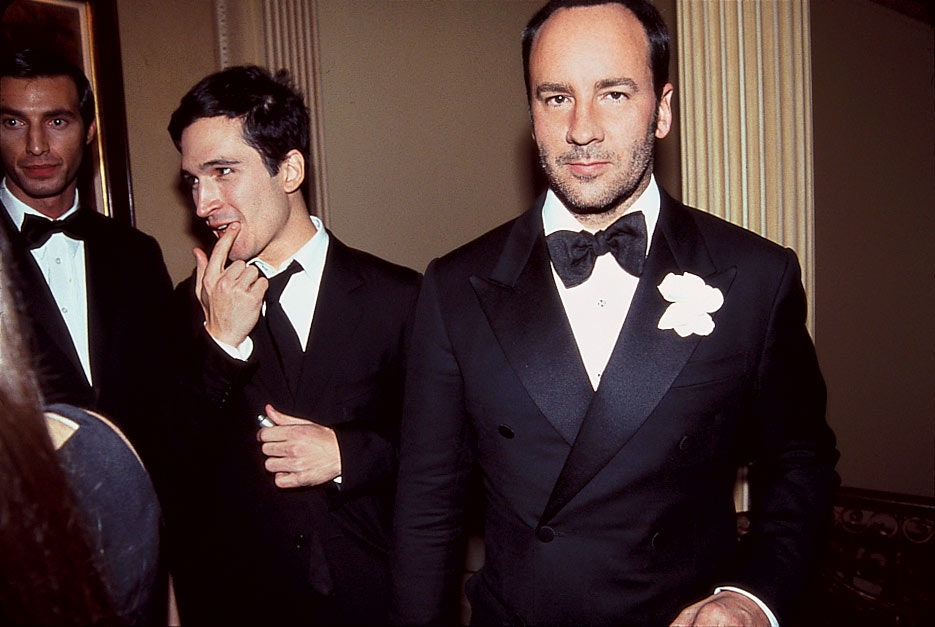
Instead, Ford followed his visual calling, enrolling in Interior Design at Parsons, the New School for Design. As part of his studies he moved to Paris for a year and half and interned in Chloe’s press office. It was here that the world of fashion really took hold of Tom Ford. Once back in New York, he graduated in 1986 with a degree in architecture, but his heart was in fashion design. Possessed with ambition, Ford became determined to land a job with the iconic American sportswear designer, Cathy Hardwick. Not mentioning his architecture major or lack of fashion experience, Ford called Hardwick’s office every day for a month, finally landing an interview.
As she recalls it, “I had every intention of giving him no hope. I asked him who his favorite European designers were. He said, ‘Armani and Chanel.’ Months later I asked him why he said that, and he said, ‘Because you were wearing something Armani.’ Is it any wonder he got the job?” Ford became a design assistant and worked under Hardwick for two years, whilst mixing socially with the fashion crowd and building his networks.
By 1988 he had formed a friendship with Robert McDonald and Marc Jacobs, landing himself a job at Perry Ellis where he designed women’s jeans. But his vision went far beyond American Fashion. In an interview with The New York Times, Ford stated,
“If I was ever going to become a good designer, I had to leave America. My own culture was inhibiting me… It’s looked down upon to be too stylish. Europeans, however, appreciate style”
Within two years he had cemented himself into the heart of European fashion, assuming the role of ready-to-wear Womenswear Designer for the iconic Italian fashion house Gucci.
At the time, Gucci was struggling to stay relevant and then creative director Dawn Mello admitted “no one would dream of wearing Gucci”. Known for leather goods, scarves and slightly anachronistic knits, the fashion was frankly outdated. By 1990, Gucci was experiencing devastating financial loss.
In stepped Tom Ford to replace Mello as Creative Director. Moving with his partner to Milan, Ford was given carte blanche to overhaul the brand and within six months was designing menswear, shoes and, with Richard Lamberton’s exit as design director, the brand’s whole creative vision.
Skyrocketing Sales
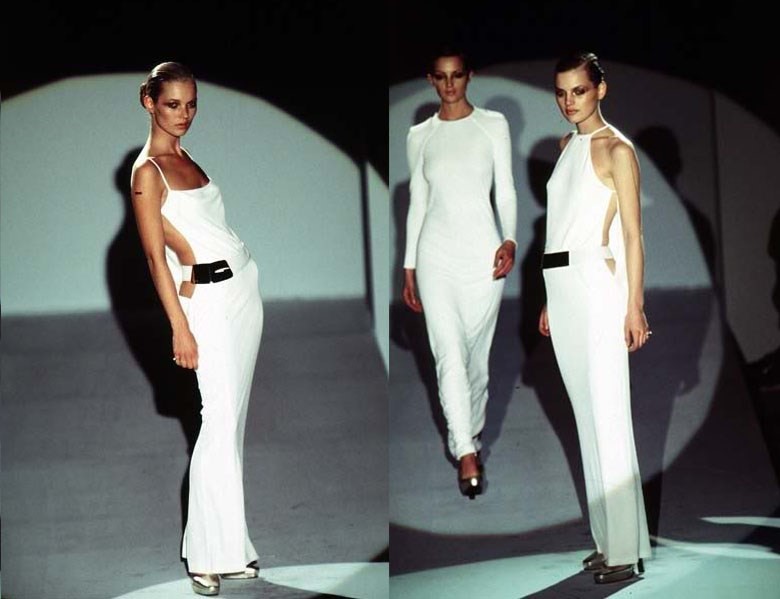
Ford was nothing if not an agent provocateur. In his first year, Ford introduced sexy Halston-style velvet hipsters, skinny satin shirts and car-finish metallic patent boots. Soon he had added knife-like stilettos, satin slip dresses and branded lingerie. By 1993 Ford worked 18-hour days, designing 11 product lines including Gucci’s imagery, advertising, ready to wear collections, fragrances, and store design. Hyper-sexy outfits, sleek suits and hip-hugging trousers for both sexes were added to the Gucci lines.
Ford’s vision paid off, raising a brand that was bankrupt and irrelevant to the hottest luxury fashion house in the world. Sales values skyrocketed. From 1995 and 1996 alone, Gucci sales increased by 90% and by 1999 the brand was worth approximately $4 billion. Ford had become the benchmark of the 90’s rebellious and incredibly sensual aesthetic.
By 2000 Yves Saint Laurent was added to Gucci’s burgeoning portfolio and by default, till 2004, Tom Ford was also creative director for the iconic French fashion brand. This was not to last. A feud flared up between the two based on creative differences. Yves Saint Laurent was clearly unhappy with the direction of his fashion label under Ford, complaining that “In 13 minutes you have destroyed what I’ve worked 40 years to create”.
Public Enemy
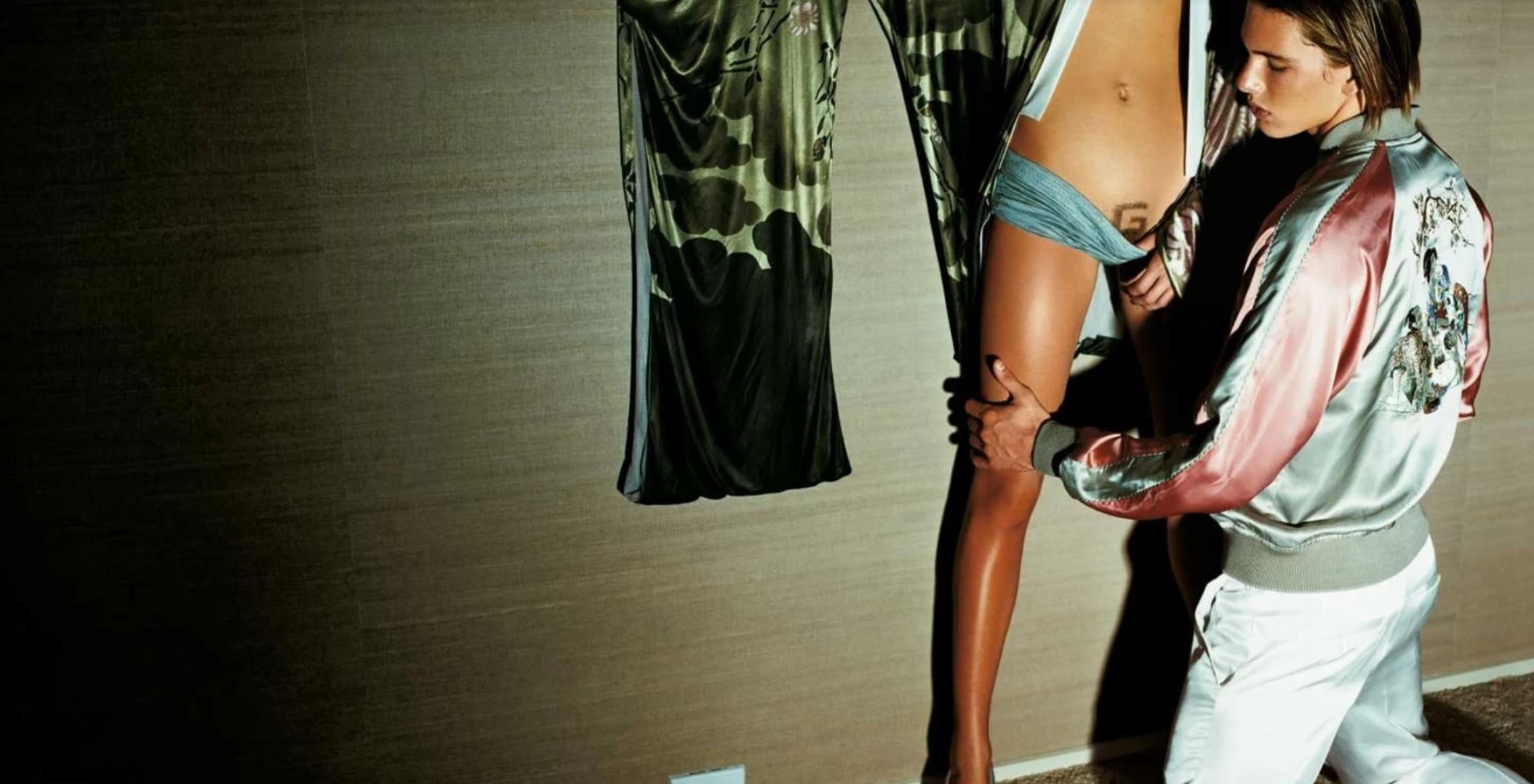
Nonetheless Tom Ford left his indelible mark, winning awards for the YSL brand and lending it much needed currency. His provocative eye, married with luxurious and simple style, is ever present in the Yves Saint Laurent branding decades after his departure. It is a testament to his unparalleled influence.
The raunchy designer also left a substantial mark on the advertising world. Never afraid to push the limits, his ads garnered wide-spread criticism for their sexually suggestive content and nudity, labelled alternatively as “obscene”, “sexist” and “vulgar”. His 2003 Gucci ‘Public Enemy’ campaign was banned for its extremely sexualised content, featuring a female model with the Gucci-logo shaved into her pubic hair. His YSL fragrance campaigns were equally divisive, featuring Sophie Dahl wearing nothing but stilettos and a necklace to sell Opium, and martial artist Samuel de Cubber showing full frontal nudity for M7. Just like Calvin Klein before him, Tom Ford was obsessed with causing a sensation through provocative and overtly sexual imagery.
After a 15-year partnership, it all ended with telltale scandal. Unwilling to meet the demands of one of Gucci Group’s biggest shareholders, Fold resigned as creative director. It was an ugly public affair –accusations came from both sides, with sordid details relished by the press. Later Ford was reported to be “devastated”. In an interview he stated that “Money had absolutely nothing to do with it at all. It really was a question of control”. By the time he left in 2004, Ford was designing 16 collections a year. Gucci Group was valued at $10 billion and 4 people were hired to fill Ford’s shoes. Struggling to find an equal, Gucci sales stagnated once more.
Household Name
Meanwhile, Ford got busy to work launching a cosmetics and fragrance line with Estée Lauder, and by 2006 had launched his own brand with the release of the now iconic fragrance collection Black Orchid. In true Ford style, his dark and dirty aesthetic challenged the clean and pretty aesthetic of other fragrances. Ford’s strong point of view had been captured in a bottle: bold, sexy and daring. The results were critically acclaimed. Inevitably by 2006, Tom Ford’s name had become the brand.
The wide popularity of Black Orchid prompted the release of a new fragrance a year later, Tom Ford for Men. With signature flare, and the adage that sex sells, the resulting campaign was even more successful, cementing words like “Vaginad” in the lexicon and sparking further controversy over the sexual objectification of women.
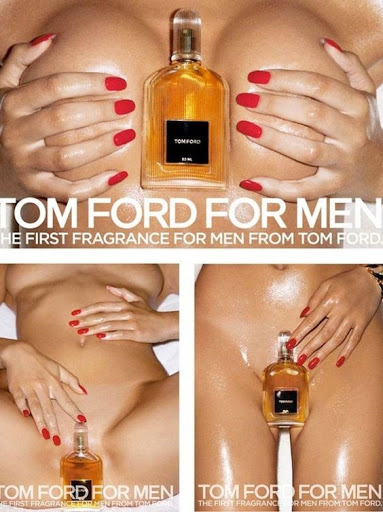
Ads for sunglasses, suits and even a Penis Pendant Necklace in the Tom Ford collection continued the Ford vision, stirring sexual political debate and breaking the rules of decency. Ford is unabashed about his choices, stating:
“I am an equal opportunity objectifier… the human body is beautiful. I am not offended remotely by it… all of us in the fashion industry objectify men and women. We’re using the human form to sell products”
And the world bought it. For his glamourous return to women’s fashion his SS11 Haute Couture collection featured Beyoncé Knowles, Julianne Moore, Rita Wilson, Farida Khelfa and Liya Kebede.
As he put it, the “Tom Ford” label catered to international, cultured, well-traveled, strong and intelligent men and women “who know their own style”. A glittering list of customers fit the description, including First Lady Michelle Obama, Beyoncé, Jennifer Lopez, Gwyneth Paltrow, Anne Hathaway, Daniel Craig, Tom Hanks, Johnny Depp, Ryan Gosling, Will Smith, Julianne Moore, Hugh Jackman, Jon Hamm, and Henry Cavill. Daniel Craig’s suits for the last three James Bond films Quantum of Solace, Skyfall, and Spectre are all care of Tom Ford.
Penetrating Pop Culture
Ford’s fashion influence has been so deep, songs have been written about it. Justin Timberlake’s 2013 song “Suit & Tie”, a collaboration with Jay Z, exclusively featured and honoured Tom Ford. The brand affiliation lead to Timberlake’s 20/20 Experience World Tour, for which Ford designed over 600 pieces. Jay Z released a song that same year titled “Tom Ford”, rapping the name numerous times in the song. The song went platinum, selling over a million copies and a huge spike in sales for Tom Ford too. The designer was reported to be flattered- “it means that one has really penetrated and made an impact on popular culture”.
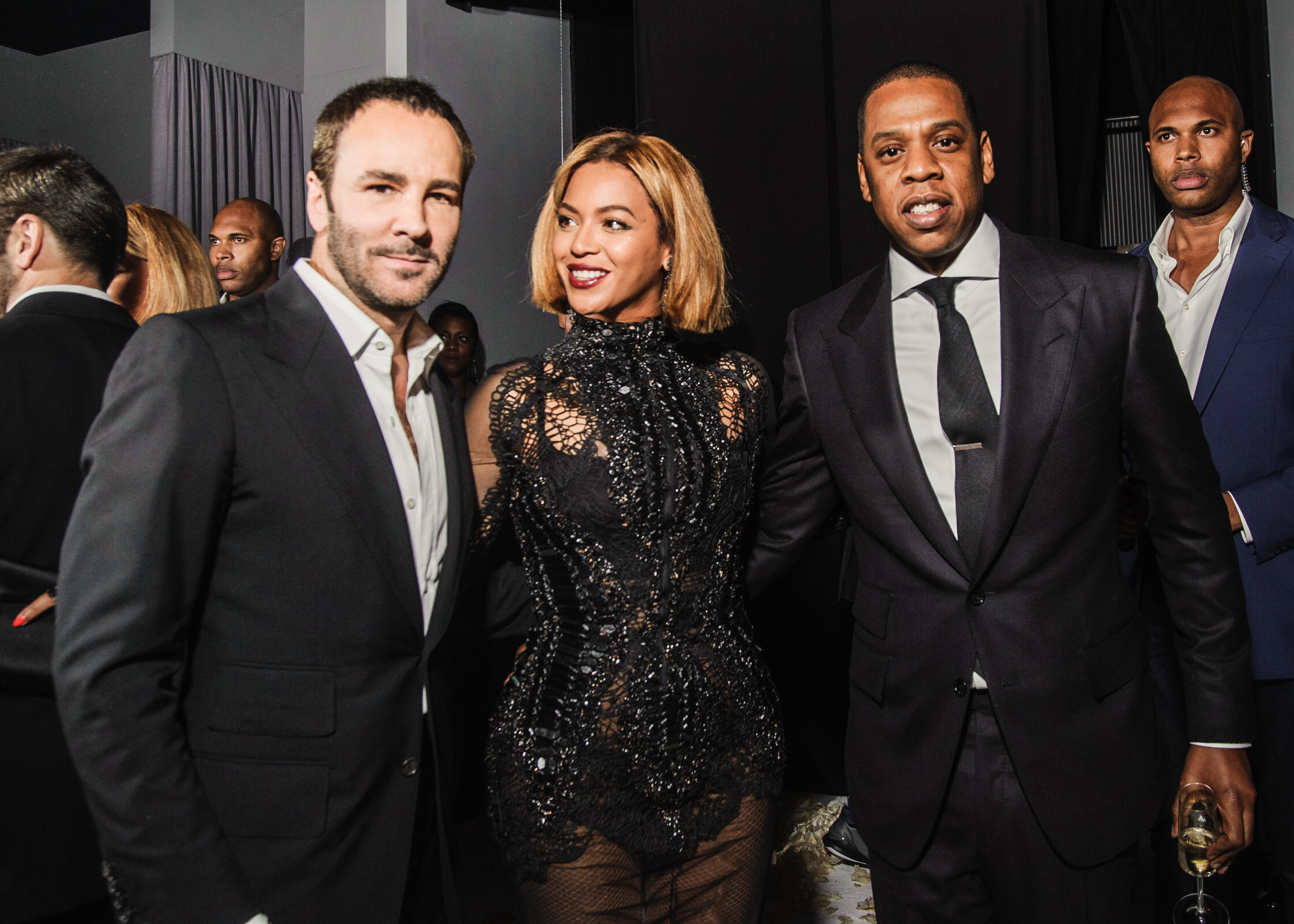
As if this was not enough of a legacy for one man, Ford’s divorce with Gucci simultaneously propelled him towards filmmaking. In the same year as launching his own label he bought the rights to Christopher Isherwood’s 1964 novel, A Single Man. Financing the film through his sizeable Gucci stock options, Ford explode onto the Hollywood radar with his stylish, dreamy and dark direction which highlighted his other passions- architecture and interior design. Starring Colin Firth, Julianne Moore, and Matthew Goode, “A Single Man” received critical acclaim, an Oscar nomination and BAFTA award for Firth as the lead George Falconer, the gay professor grieving the loss of his partner in1960s Los Angeles.
Ford would go on to direct Nocturnal Animals. Starring Amy Adams and Jake Gyllenhaal and based on the 1993 novel Tony and Susan. Following the breakdown of a gallerist living a shallow, materialistic life, much of the sentiments were mirrored in Ford’s own experiences.
It is equally through his films that Ford showcases the style that garnered him worldwide popularity in the fashion industry, having an intricate understanding of glamour, beauty, sophistication, and sexual seduction. His game is design, regardless of the form.
Always looking to grow as an artist, his stable private life with long-term partner Richard across New York, Los Angeles, and London has also seen him Ford construct Cerro Pelon Ranch in Santa Fe, a 24,000-acre private tract designed by Japanese architect Tadao Ando with an entirely fictional town known as Silverado, which is used as a filming location for Hollywood Westerns.
A Common Thread

Tom Ford’s position as a lynchpin in the modern Fashion industry was cemented when he was elected to be chairman of “The Council of Fashion Designers of America (CFDA)” from 2020. This too has not been without telltale controversy. World events including race riots, growing environmental concerns and a pandemic have conspired to make his job one of implementing change and innovation within the structure of the stalwart Fashion industry itself.
Publicly going Vegan, eschewing fur in his designs, and implementing smaller, more global runway shows online through platforms like Runway360, Ford has paired with Anna Wintour to implement a pandemic relief fund for designers titled “A Common Thread”.
Following the growth of the Black Lives Matter campaign, Ford implemented a new Black advisory board to create opportunities, help foster equity and inclusion across the industry and internally at the CFDA. Citing that the goal was to bring “an end to racial injustice in the fashion industry,” Ford replaced the likes of Kara Ross, Georgina Chapman, Marcus Wainwright and Mimi So on the Board with Black designers and innovators Virgil Abloh, Maria Cornejo, Carly Cushnie and Kerby Jean-Raymond. Despite this he has faced criticism over what is seen as a tokenistic move that doesn’t truly address the need for systemic change within the industry. 250 Black professionals sent a petition to the CFDA, demanding more action. Titled “The Kelly Initiative,” after legendary Black designer Patrick Kelly, the letter stated:
“In its over 2 years of refusing to consider and implement key equity realization programs aimed at leveling the playing field for the community of Black fashion professionals, the CFDA has allowed exploitative cultures of prejudice, tokenism, and employment discrimination to thrive, unbridled by the sort of watchdog intervention expected of an industry umbrella organization. Now, hasty attempts at doing that work—initiatives released on June 4th, so insufficiently conceived that they lacked a very name—evidence that the CFDA is falling far short of the broader culture’s rapidly solidifying zero-tolerance policy for Anti-Blackness.”
Other voices are citing more direct action to equalise the gap. Designer Aurora James is asking major retailers to dedicate 15% of their shelf space to Black brands in line with market demographics. It’s clear that the Fashion Industry has a long way to go to come into line with global shifts, but with Tom Ford at the helm it’s a space that will be fascinating to watch.
Even though Ford characterises himself as insecure and shy, he is the charismatic, powerhouse of the modern era. Slogans such as “Tom Ford’s fashion is Hollywood” and “Tom Ford is fashion” do not seem off the mark. A world-class Artist, entrepreneur, and innovator, Tom Ford is the epitome of success and will forever be instilled in society’s psyche for his bold and unique vision.
Subscribe to FIB’s Weekly Alchemy Report for your weekly dose of music, fashion and pop culture news!






